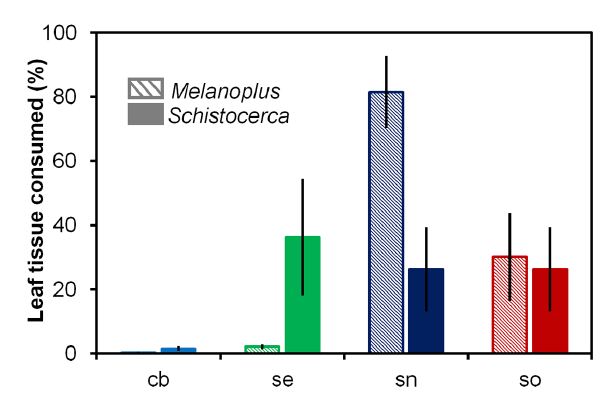
Ecological Archives C006-053-A1
Philip G. Hahn and John L. Orrock. 2015. Spatial arrangement of canopy structure and land-use history alter the effect that herbivores have on plant growth. Ecosphere 6:193. http://dx.doi.org/10.1890/es15-00036.1
Appendix A. Grasshopper feeding preferences.
We conducted cafeteria-style feeding trials between 04 September and 11 September 2013 using the two most common species of grasshopper present at our site: Melanoplus angustipennis and Schistocerca alutacea (Hahn and Orrock 2015). Grasshoppers were collected from the SRS and kept in small (1 gallon) ventilated plastic containers for at least 5 days prior to the feeding trials. Grasshoppers were fed leafy lettuce ad libatum. Test leaves were collected from mature plants in the field. The stem was clipped, immediately placed in a water pick, and returned to the greenhouse. One similarly sized leaf (~6–10 cm²) attached to the stem in the waterpick of each of the four plant species (Carphephorus bellidifolius, Sericocarpus tortifolius, Solidago nemoralis and Solidago odora) were placed in a 60×45×45cm ventilated plastic cage filled with ~5cm of potting soil. Grasshopper were then introduced into the cages and allowed to feed for 48 hours. After 48 hours, we visually estimated the percent of each leaf that was consumed, to the nearest 5%. Trials were conducted in a greenhouse under sunny conditions at ambient air temperature.
Fig. A1. Mean percent leaf tissue consumed after 48 hours in cafeteria style feeding trials for two grasshopper species (Melanoplus angustipennis and Schistocerca alutacea). Plant species are: cb = Carphephorus bellidifolius, se = Sericocarpus tortifolius, sn = Solidago nemoralis, and so = Solidago odora. Error bars are ±1 SE.
Literature Cited
Hahn, P. G., and J. L. Orrock. 2015. Land-use history alters contemporary insect herbivore assemblages and decouples plant-herbivore relationships. Journal of Animal Ecology 84:745–754.